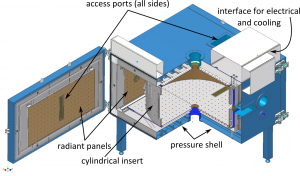Building a Cloud Chamber for Collaborative Research
NSF MRI: Development of a Turbulent Cloud Chamber
NSF Major Research Instrumentation Program, 2010-2013 (Extended to 2015)

Multiphase Reaction Chamber for studies of aerosol and cloud processes. The Chamber is contained within a pressure vessel approximately 1.5 x 2.5 x 2.5 m with several access ports and optical windows. The refrigeration and pump controls are housed in a separate section. Access to the Chamber is through two swing doors (front and back) for cleaning and exchange of Chamber interior parts.
This effort will develop a laboratory cloud chamber to assess impacts of well-characterized turbulence (generated via Rayleigh-Benard convection) on cloud microphysics and aerosol processing. The cylindrical chamber will have a working volume of 3.14 m^3 and be capable of simulating a full range of tropospherically relevant temperatures and pressures (viz. 50 to 20 degC and 10^4 to 10^5 Pa). Supporting instrumentation will allow for generation and detailed characterization of aerosol and cloud particles, measurement of thermodynamic and turbulent properties, and sampling of particles for subsequent chemical and morphological analysis. Topics of immediate interest would include: turbulence, mixing and associated fluctuations of cloud properties; ice processes, including primary nucleation and secondary ice formation; aerosol and cloud chemistry; and both optical and morphological characterization of aerosols. A numerical cloud model will be adapted to simulate and further evaluate processes occurring within the chamber. Aerosol/cloud-particle transformations and the interactive chemical and turbulent processes that influence them are a major focus of this facility. The Intellectual Merit of this work hinges on improved understanding of processes having strong implications for their proper representation of formation of clouds and precipitation, their interactions with aerosol and chemical constituents, and ultimately the role of clouds in the global climate system.
As for the Broader Impacts, this comprehensively equipped cloud chamber facility will represent an important addition to U.S. scientific infrastructure for laboratory-based environmental studies, and will be particularly unique in coupling the ability to simulate clouds occurring in a desirably broad range of atmospheric temperatures and pressures with well-characterized turbulence. The chamber will be housed in the new Great Lakes Research Center, which will provide ready access by investigators residing at Michigan Tech and, after time for required initial development and testing, by investigators from across the U.S.
MS student DM Ashraf Ul Habib and Ph D student Matthew Brege contribute to this project.
See also our Video update
